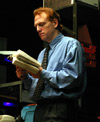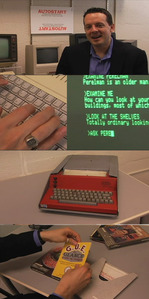I’m here in Banff (in Alberta, Canada) at the cutting edge, or maybe the precipitous edge, or, as I’d prefer to think, the connecting edge. The occasion is In(ter)ventions: Literary Practice at the Edge: A Gathering, organized by Steven Ross Smith.
The presenters include: Charles Bernstein, Jen Bervin, Christian Bök, J.R. Carpenter, Maria Damon, Ram Devineni, Craig Dworkin, Al Filreis, Christopher Funkhouser, Kenneth Goldsmith, D Kimm, Larissa Lai, Daphne Marlatt, Nick Montfort, Erin Moure, Lance Olsen, Stephen Osborne, Kate Pullinger, Stephanie Strickland, Steve Tomasula, Fred Wah.
The presentations (which include critical papers, but also many readings, screenings, performances, and artists’ talks) have been provocative and have unfolded new types of beauty and new understandings of process.
On Thursday, February 18, I was honored to join Larissa Lai and Chris Funkhouser as part of the opening reading. I read from Implementation (a collaboration with Scott Rettberg) and ppg256, concluding with the premiere of a new poety generator in this series, ppg256-5:
perl -le '@a=split/,/,"conceptual,digit,flarf,maximal,modern,pixel,quiet,real";sub f{pop if rand>.5}sub w{$a[rand@a]}{print f("post").w."ism ".w."s ".f("the ").w."\n".(" "x45)."WHAT DOES ppg DO?";$a[rand@a]=~s/[aeio]/substr("aeio",rand 4,1)/e if $l++>5;sleep 5;redo}'
As I explained in my talk the next morning, this program is based on a section in the middle of Tristan Tzara’s February 1921 Dada Manifesto, a section that begins:
cubism constructs a cathedral of artistic liver paste
WHAT DOES DADA DO?
expressionism poisons artistic sardines
WHAT DOES DADA DO?
If you run ppg256-5 (which is the real way to experience the program) it might begin:
postmodernism flarfs digit
WHAT DOES ppg DO?
realism reals the conceptual
WHAT DOES ppg DO?
Because this section of Tzara’s manifesto ends “50 francs reward to the person who finds the best way to explain DADA to us,” so I concluded by presentation similarly, offering a 50 character reward for the person who finds the best way to explain ppg to us. Chris Funkhouser said, “It does a lot with a little.” John Cayley offered that “ppg combines atoms of language.” These aren’t bad explanations, but the most impressive so far has been from Travis Kirton, who, without having any previous experience programming in Perl, created and sent me this modified version of ppg256-5:
perl -le '@a=split/,/,"illmn,imgn,ltr,mut,pxl,popl,strlz,pnctu,typfc,poetc,glmr,idl,ion,cptl,cpsl,cvl,atom,pltc,txtul,erotc,rvl";sub f{pop if rand>.5}sub w{$a[rand@a]}{print f("de").f("over").w."izes ".w."ation".f("s")."\n".(" "x45)."IS WHAT ppg DOES!";sleep 5;redo}'
A run of this may begin by outputting:
deltrizes ionation
IS WHAT ppg DOES!
deoverltrizes mutations
IS WHAT ppg DOES!
I’ll have to see if anything can top that and earn the 50-character reward.
Here’s what’s being said on Twitter about the conference. I’ve found that one participant, Claire Lacey, has been writing about In(ter)ventions on her blog poetactics. Finally, here are just a handful of memorable (mis)quotes to give you another impression, however slanted, of this gathering:
Stephanie Strickland: “The front of your wave is the back of someone else’s.”
Steve Tomasula, in reference to Magritte: “No one ever says that this isn’t a cigarette:
 ”
”
My mishearing of Maria Damon, who was discussing healthy eating with someone as we were descending a staircase: “You need a multi-prawn strategy.”
D Kimm: “We are always unknown to someone.”
Update: Steven Osborne has just launched a blog with a post about the conference.


 ”
”

